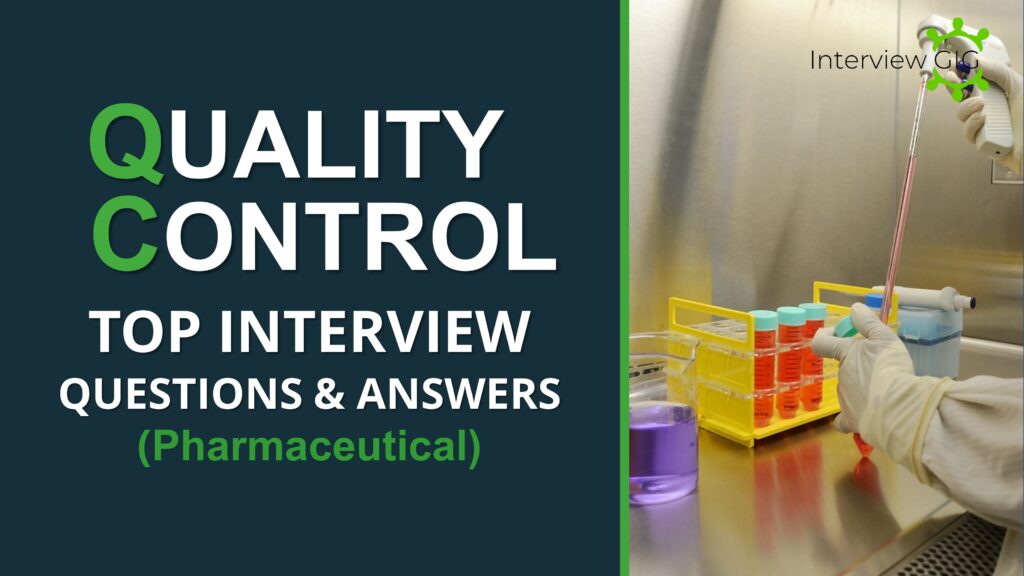Quality Assurance Interview Questions
In the pharmaceutical world, where safety comes first, Quality Assurance (QA) acts as the guardian of trust. Quality Assurance (QA) in the pharmaceutical industry plays a pivotal role in ensuring the safety, efficacy, and compliance of medicinal products. It encompasses a systematic approach to quality management, covering processes from development to manufacturing and distribution. QA involves adherence to regulatory standards, implementation of Good Manufacturing Practices (GMP), and continuous improvement to uphold product quality and patient safety.
Commonly asked QA interview questions and answers for both freshers and experienced candidates.
Question: What is the role of QA in the pharmaceutical industry?
Answer: Quality Assurance (QA) plays a critical role in the pharmaceutical industry, safeguarding public health and ensuring the safety, efficacy, and quality of medications. QA professionals are responsible for:
Establishing and maintaining quality standards: They define quality requirements for all aspects of drug development, manufacturing, and distribution.
Monitoring and auditing processes: They ensure compliance with Good Manufacturing Practices (GMP) and other regulations.
Reviewing and approving documentation: They evaluate data, reports, and procedures to ensure accuracy and completeness.
Investigating deviations and non-conformances: They identify and address potential quality issues promptly.
Implementing corrective and preventive actions: They work to prevent future occurrences of quality problems.
Providing training and guidance: They educate staff on quality procedures and regulations.
Question: What is the concept of Good Manufacturing Practices (GMP) and its significance in pharmaceutical QA?
Good Manufacturing Practices (GMP) are a set of guidelines and principles that govern the manufacturing of pharmaceuticals, ensuring that products are consistently produced and controlled to meet quality standards. GMP covers various aspects, including facility cleanliness, personnel hygiene, equipment validation, record-keeping, and quality control. Adherence to GMP is essential for pharmaceutical QA as it helps prevent contamination, mix-ups, and errors, ultimately ensuring the safety and efficacy of the produced medicines.
Question: Can you explain the importance of cGMP?
Answer: cGMP is an extension of GMP, emphasizing the need for continuous improvement and adaptation to evolving technologies and scientific advancements. It ensures that manufacturing processes are up-to-date, efficient, and capable of consistently producing high-quality pharmaceutical products. The importance of cGMP lies in its focus on ongoing compliance and its role in maintaining and enhancing product quality throughout the product lifecycle.
Question: What are the different types of quality control tests used in pharmaceutical manufacturing and how they ensure product quality?
Answer: Types of Quality Control Tests in Pharmaceutical Manufacturing:
- Identity Tests: Confirm the identity of raw materials and finished products.
- Purity Tests: Ensure that the product is free from impurities, including contaminants and by-products.
- Potency Tests: Assess the strength or concentration of the active pharmaceutical ingredient (API) in the product.
- Uniformity Tests: Check for uniform distribution of the API and other components within the product.
- Dissolution Tests: Evaluate the release of the drug substance from the dosage form.
- Microbiological Tests: Assess the microbial quality of pharmaceutical products.
- Stability Tests: Determine the shelf life and how the product’s quality changes over time.
These tests collectively ensure that pharmaceutical products meet quality specifications and comply with regulatory standards.
Question: What are the key regulations and guidelines relevant to QA in pharma?
Answer:
FDA Regulations: The U.S. Food and Drug Administration provides guidelines, including the Code of Federal Regulations (CFR) Title 21, covering various aspects of pharmaceutical manufacturing and quality control.
ICH Guidelines: The International Council for Harmonisation of Technical Requirements for Pharmaceuticals for Human Use (ICH) provides global guidelines to ensure the harmonization of regulatory requirements.
EU GMP Guidelines: The European Union provides Good Manufacturing Practice guidelines for medicinal products for human and veterinary use.
WHO Guidelines: The World Health Organization issues guidelines for pharmaceutical quality assurance, including GMP for pharmaceutical products.
PIC/S Standards: The Pharmaceutical Inspection Co-operation Scheme provides standards and guidelines for the inspection of pharmaceutical manufacturers.
Question: How do you approach the qualification and validation of analytical methods in QA processes?
Answer: Analytical methods are fundamental to ensuring product quality, and their qualification and validation are crucial steps in QA processes. Here’s how they are approached:
Qualification:
- Design Qualification (DQ): Documents the design intent and suitability of the analytical equipment, instruments, and software used.
- Installation Qualification (IQ): Verifies proper installation, configuration, and calibration of the equipment and software according to specifications.
- Operational Qualification (OQ): Demonstrates the equipment and software perform consistently and meet predefined acceptance criteria under intended operating conditions.
Validation:
- Performance Qualification (PQ): Evaluates the analytical method’s analytical performance characteristics (accuracy, precision, specificity, limit of detection, linearity, etc.) using standardized protocols and reference materials.
- Robustness Qualification (RQ): Assesses the method’s resistance to minor variations in operating parameters and environmental conditions.
- System Suitability Testing: Periodically verifies the method’s continued performance within acceptable limits before each analytical run
Question: Can you explain the concept of process validation and the stages involved in it.
Answer: Process validation ensures the manufacturing process consistently produces a drug product that meets its predetermined specifications. It involves these stages:
Process Definition: Documenting the manufacturing process steps, equipment, materials, and controls.
Retrospective Analysis: Reviewing historical data to identify critical process parameters (CPPs) and critical quality attributes (CQAs).
Prospective Validation: Conducting experiments to demonstrate the process consistently produces a product within acceptable CQA ranges.
Continued Process Verification: Periodically monitoring CPPs and CQAs to ensure the process remains validated.
Question: What is the purpose of a validation process in pharmaceutical manufacturing?
Answer:
Validation serves several critical purposes:
Ensures product quality and consistency: By demonstrating the methods and processes work as intended, validation minimizes the risk of producing defective products.
Provides evidence for regulatory compliance: Validation data is essential for regulatory submissions and inspections, demonstrating adherence to GMP and other regulations.
Reduces risk of product failures and recalls: Proactive validation helps prevent costly and harmful product recalls.
Improves process efficiency and cost control: By identifying and controlling critical process parameters, validation can optimize manufacturing and minimize waste.
Question: How do you ensure compliance with regulatory requirements in QA processes?
Regular Audits: Conduct internal and external audits to assess compliance.
Documentation: Maintain comprehensive records to demonstrate adherence to regulations.
Training: Ensure personnel are trained on relevant regulations and guidelines.
Stay Informed: Stay abreast of evolving regulatory requirements through continuous monitoring.
Question: Describe the importance of documentation in QA and provide examples of essential documents?
Answer:
- Traceability: Provides a clear trail of activities, facilitating traceability and accountability.
- Regulatory Compliance: Essential for demonstrating compliance with regulations and guidelines.
- Decision Support: Aids in decision-making processes by providing a historical record.
- Examples of Essential Documents:
- Standard Operating Procedures (SOPs): Documenting step-by-step procedures for various processes.
- Batch Records: Recording details of each batch of product manufactured.
- Validation Protocols and Reports: Outlining the approach and results of validation studies.
- Change Control Records: Documenting changes made to processes or systems.
- Training Records: Tracking the training history of personnel.
- Quality Manuals: Summarizing the quality management system and procedures.
Question: What is the role of Quality by Design (QbD) in pharmaceutical development and manufacturing.
Answer:
- Systematic Approach: QbD is a systematic and scientific approach to pharmaceutical development and manufacturing that emphasizes understanding the product and process.
- Risk Management: It involves identifying critical quality attributes (CQAs), understanding how they are influenced by various factors (critical process parameters), and implementing strategies to mitigate risks.
- Consistent Quality: QbD aims to design and develop processes that consistently produce a product with the desired quality attributes.
- Continuous Improvement: It promotes continuous improvement by utilizing knowledge gained throughout the product lifecycle.
Question: Discuss the principles of Risk-Based Quality Management (RBQM) in the pharmaceutical industry.
Answer:
RBQM prioritizes efforts based on potential risks to product quality. Key principles include:
- Risk assessment: Identifying, analysing, and evaluating potential risks throughout the product lifecycle.
- Risk mitigation strategies: Implementing controls to minimize the likelihood and impact of identified risks.
- Resource allocation: Directing resources towards controlling significant risks instead of spreading them thin.
- Continuous improvement: Regularly reviewing and updating risk assessments and mitigation strategies based on new data and experience.
RBQM benefits include:
- More efficient use of resources: Focus on high-risk areas allows for optimized resource allocation.
- Improved risk management: Proactive identification and mitigation of potential problems.
- Enhanced regulatory compliance: Demonstrates a systematic approach to managing quality risks.
Question: What is the difference between a deviation and a change control in the context of pharmaceutical QA?
Answer:
Deviation: A deviation is an unplanned divergence from an approved process or procedure. It represents a departure from the standard manufacturing or testing process and may require investigation and corrective actions.
Change Control: Change control is a systematic process to propose, evaluate, approve, and implement changes to processes, systems, or documents in a controlled manner. Unlike deviations, changes are planned and intentional.
Question: Explain the term “batch record review” and its significance in QA?
Answer: A batch record review is a comprehensive evaluation of all documentation associated with a specific batch of drug product. It verifies that all manufacturing steps were performed according to established procedures and specifications. Key aspects reviewed include:
- Raw material testing results
- In-process control data
- Finished product testing results
- Equipment calibration records
- Deviations and their resolutions
Batch record review ensures:
- Compliance with regulations and quality standards
- Consistency and traceability of the manufacturing process
- Identification and correction of any potential quality issues
Question: How do you handle deviations from quality standards in a pharmaceutical manufacturing setting?
Answer:
- Immediate Investigation: Deviations are promptly investigated to determine their root cause.
- Corrective Actions: Implement corrective actions to address the identified issues and prevent recurrence.
- Documentation: Thoroughly document the deviation, investigation, and corrective actions taken.
- Review and Approval: Have a review and approval process for deviations and associated corrective actions.
- Communication: Ensure clear communication within the organization regarding the deviation, its impact, and the corrective measures taken.
Question: What are the core principles of data integrity in QA?
Answer: Data integrity is crucial in QA to ensure the reliability and trustworthiness of data used for decision-making. The core principles are often summarized as ALCOA+ (sometimes ALCOA++):
- Attributable: All data entries must be linked to a specific individual who performed the measurement or test.
- Legible: Data should be recorded clearly and permanently, avoiding handwritten entries or easily erased formats.
- Contemporaneous: Data should be recorded at the time of observation or completion of the activity, not retrospectively.
- Original: Data should be documented in its original form, avoiding transcription errors and maintaining traceability.
- Accurate: Data should be free from errors, complete, and reflect the true observations made.
- Complete: All relevant data should be recorded, including raw data and calculations.
- Consistent: Data should follow a consistent format and use standardized terminology throughout.
- Enduring: Data records should be stored securely and remain accessible for the required period.
- Available: Data must be readily available for authorized personnel for review and audit purposes.
Question: How do you handle out-of-specification (OOS) results in pharmaceutical manufacturing?
Answer: OOS results, where data falls outside predefined acceptable limits, demand a rigorous and documented response:
- Immediate investigation: Identify the root cause of the OOS result, considering factors like instrument calibration, human error, or process variability.
- Impact assessment: Evaluate the potential impact on product quality and safety based on the severity and frequency of the OOS.
- Corrective and preventive actions (CAPA): Implement actions to address the root cause and prevent future occurrences. This might involve re-testing, equipment recalibration, or process adjustments.
- Documentation: Thoroughly document the entire process, including the OOS result, investigation, CAPA plan, and implementation.
- Regulatory reporting: Report OOS results to regulatory authorities as required by specific regulations.
Question: Explain the role of QA in the change control process and its impact on product quality.
Answer: Change control is a formal process for managing modifications to procedures, specifications, or equipment used in manufacturing. QA plays a vital role:
- Reviewing and assessing proposed changes: QA evaluates the potential impact of changes on product quality, safety, and regulatory compliance.
- Approving or rejecting changes: Based on the assessment, QA provides approval or recommends against the change.
- Monitoring implementation: QA ensures the change is implemented according to the approved plan and verifies its effectiveness.
- Documenting the entire process: All aspects of the change control process are meticulously documented for traceability and audit purposes.
Effective change control minimizes risks associated with modifications, ensuring product quality remains consistent and meets regulatory requirements.
Question: Discuss the role of statistical process control (SPC) in pharmaceutical manufacturing?
Answer:
- Quality Monitoring: SPC involves the use of statistical tools to monitor and control processes, ensuring they remain within specified limits.
- Variability Reduction: Identifies trends, shifts, or abnormal patterns in data, allowing for proactive correction of issues and reduction of process variability.
- Continuous Improvement: SPC supports continuous improvement efforts by providing real-time data insights into process performance.
- Quality Assurance: SPC helps in maintaining process stability and preventing deviations from quality standards.
Question: What is the concept of continuous improvement in pharmaceutical QA and provide examples of its application.
Answer:
- Plan-Do-Check-Act (PDCA) Cycle: Implementing the PDCA cycle for continuous improvement.
- Root Cause Analysis: Investigate issues to identify and address underlying causes.
- Training and Development: Continuous improvement in personnel skills and knowledge.
- Feedback Mechanisms: Establishing mechanisms for collecting feedback from processes and stakeholders.
- Implementation of Best Practices: Adopting industry best practices to enhance efficiency and product quality.
- Regular Audits: Conducting internal and external audits to identify areas for improvement.
Question: Explain the role of stability testing in ensuring product quality?
Answer: Stability testing plays a critical role in ensuring the quality of pharmaceutical products throughout their shelf life. It involves:
- Determining Shelf Life: Stability testing assesses how the quality of a pharmaceutical product changes over time, helping to establish its shelf life.
- Quality Monitoring: It provides insights into the physical, chemical, and microbiological stability of a product under various storage conditions.
- Regulatory Compliance: Stability data is crucial for regulatory submissions and demonstrates that the product maintains its quality and efficacy throughout its intended shelf life.
- Risk Mitigation: Identifies potential degradation pathways and supports the establishment of storage conditions to mitigate these risks.
Question: What experience do you have with different analytical techniques used in pharmaceutical quality control, such as HPLC, GC, and spectroscopy?
Answer:
- HPLC (High-Performance Liquid Chromatography): Used for separation and quantification of components in a mixture.
- GC (Gas Chromatography): Applied for analyzing volatile compounds.
- Spectroscopy (UV, IR, NMR): Utilized for identifying and quantifying compounds based on their interaction with light.
- Wet Chemistry Techniques: Titration and gravimetric analysis for certain chemical analyses.
- Particle Size Analysis: Techniques like laser diffraction for assessing the size of particles in formulations.
Question: What are the different types of documentation used in quality assurance?
Answer: Comprehensive documentation is essential for QA practices. Examples include:
- Standard Operating Procedures (SOPs): Detailed instructions for performing specific tasks and processes.
- Batch records: Detailed records of all manufacturing activities for each batch of product.
- Analytical records: All data and results generated during analytical testing.
- Calibration and maintenance records: Records of equipment calibration and maintenance activities.
- Deviation reports: Documents any deviations from SOPs and corrective actions taken.
- Validation protocols and reports: Documents outlining the validation process and its results.
- Training records: Records of personnel training on QA procedures and regulations.
Question: Explain your understanding of the ICH guidelines and their impact on quality assurance practices?
Answer: International Council for Harmonisation of Technical Requirements for Pharmaceuticals for Human Use (ICH):
- Impact on QA: ICH guidelines provide global standards for the development, registration, and post-approval phases of pharmaceutical products.
- Harmonization: They promote harmonization of regulatory requirements to ensure consistency in the interpretation and application of standards.
- Quality Standards: ICH guidelines influence QA practices by setting standards for quality, safety, efficacy, and documentation requirements.
Question: What are your thoughts on the future of QA in the pharmaceutical industry?
Answer: The future of QA in the pharmaceutical industry is likely to be shaped by several trends:
- Increased use of data analytics: Employing Big Data and AI to predict potential quality issues and optimize processes.
- Digitalization and automation: Utilizing automation in tasks like data collection and analysis to improve efficiency and accuracy.
- Continuous improvement: Embracing continuous learning and improvement culture to adapt to evolving regulations and technologies.
- Focus on patient-centric approaches: Prioritizing quality attributes that directly impact patient safety and experience.
By embracing these trends, QA professionals can continue to play a vital role in ensuring the development, manufacture, and distribution of safe, effective, and high-quality medications.
Below are some useful Topics for interview questions and answers related to pharmaceuticals, covering Production, Pharma safety , Organic Chemistry, Chemist R&D ,Pharmacist ,and Quality Control roles.
- Pharma Safety Interview Questions and Answers
- Pharmaceutical Production Interview Questions and Answers 2024
- Safety Officer Interview Questions And Answers
- Chemist Interview Questions and Answers (Basics & Organic Chemistry)
- Quality Control Interview Questions & Answers In Pharma
- Pharmacist Interview Questions And Answers
- Chemist Interview Questions for Production and R&D





